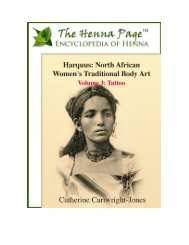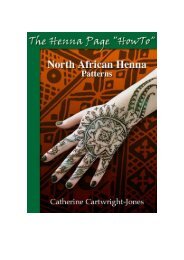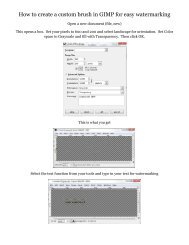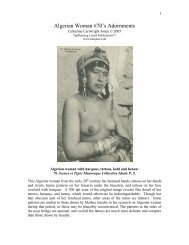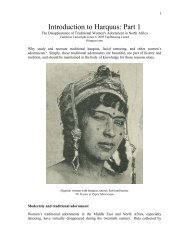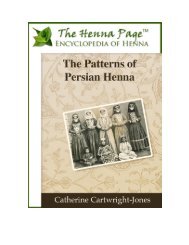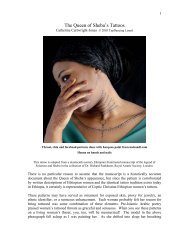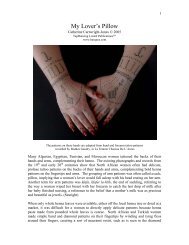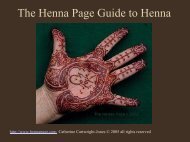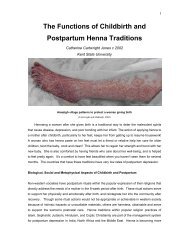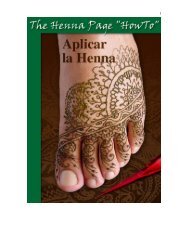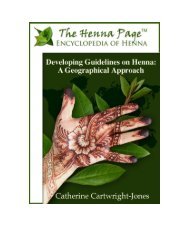Menstruation and Henna: Pollution and Purification - The Henna Page
Menstruation and Henna: Pollution and Purification - The Henna Page
Menstruation and Henna: Pollution and Purification - The Henna Page
Create successful ePaper yourself
Turn your PDF publications into a flip-book with our unique Google optimized e-Paper software.
sacred soil, transforming her to a “Bride of Heaven”. In Turkish folk songs, henna is said to be<br />
auspicious, <strong>and</strong> a bringer of fertility (Delaney, 1991, 137-9). In this localized interpretation of<br />
henna as a purifier of reproductive blood, <strong>and</strong> negotiator for health <strong>and</strong> fertility, the focus was on<br />
henna as a metaphor for pure, fertile soil. Turkish folk belief, <strong>and</strong> the Koran both compared a<br />
woman’s womb to a fertile field, to kept pure for implantation with seed or semen. Menstrual<br />
blood was considered very defiling (Delaney, 1988, 83-5), <strong>and</strong> the purification following<br />
menstruation <strong>and</strong> marital intercourse generally included henna application to hair, feet <strong>and</strong><br />
fingertips.<br />
<strong>Henna</strong>’s use in aspects of reproductive health, including the manifestations of attack by the<br />
Evil Eye or Jinn<br />
In old Islamic medical tradition, illnesses <strong>and</strong> injuries did not simply occur, they befell a victim in<br />
a particular manner <strong>and</strong> at a particular time because of specific causal actions. Both the Evil Eye<br />
<strong>and</strong> Jinn could enter through an opening in the body: a wound, the eyes, mouth, vagina or other<br />
orifice, <strong>and</strong> once inside a woman’s body, could cause mental, emotional or physical disease<br />
(Shiloh, 1968: 235). Both the Evil Eye <strong>and</strong> Jinn imperiled women <strong>and</strong> both were averted with<br />
henna. People could knowingly or unknowingly cast the Evil Eye on a woman, or it could be<br />
from a disembodied source. Women often regarded co-wives or other women in their community<br />
as likely sources of the Evil Eye, <strong>and</strong> the reason for various reproductive <strong>and</strong> emotional<br />
difficulties. Women applied henna <strong>and</strong> henna patterns to relieve these problems.<br />
Migraines <strong>and</strong> headaches accompany menstruation, <strong>and</strong> henna was the traditional treatment in<br />
Islamic medicine. <strong>The</strong> Prophet Mohammed suffered from migraines <strong>and</strong> would apply henna to<br />
his head to relieve the pain, saying, “It (henna) is beneficial for headache by God’s permission”<br />
(Al-Jawziyya, 1998: 63-5). A person must sit quietly for up to several hours for henna to stain<br />
“<strong>Menstruation</strong> <strong>and</strong> <strong>Henna</strong>, <strong>Pollution</strong> <strong>and</strong> <strong>Purification</strong>”, was written by Catherine Cartwright-Jones as partial completion<br />
of the requirements for a Master’s degree in Liberal Studies focusing on henna, under the supervision of Dr. A Smith<br />
<strong>and</strong> Dr. N Ammar, Kent State University, Kent Ohio, USA<br />
38



